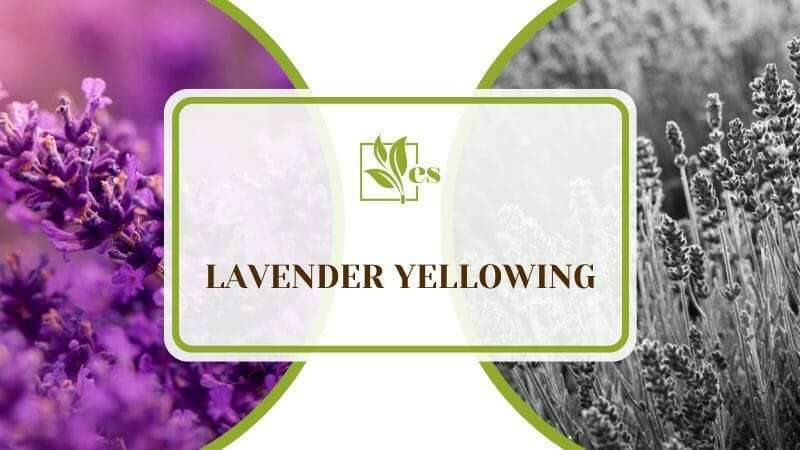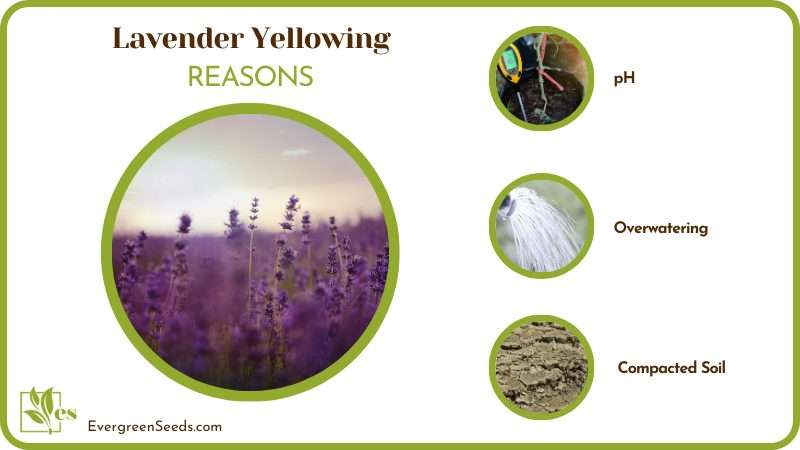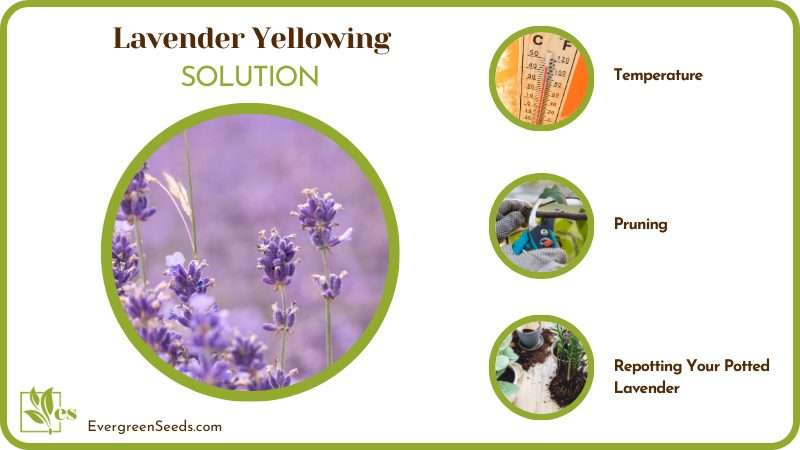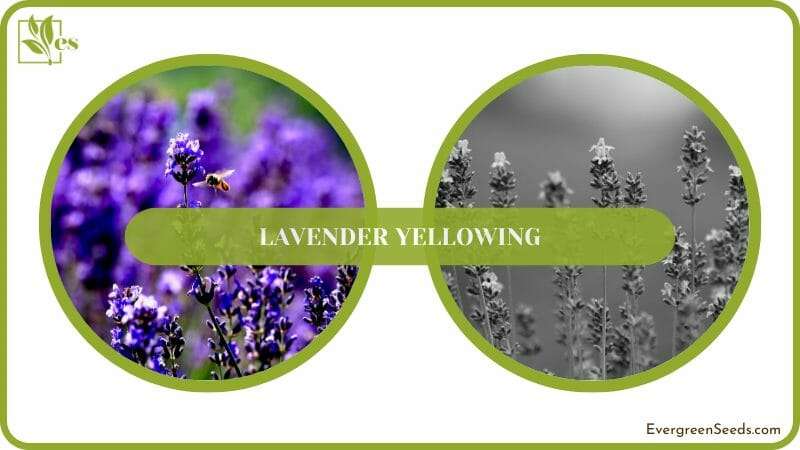- How Tall Does Rosemary Grow: A Guide for Gardeners - October 22, 2024
- How Tall Do Cucumber Plants Grow: A Guide for Gardeners - October 22, 2024
- How Tall Do Dahlias Grow: A Guide for Gardeners - October 22, 2024
Lavender yellowing is not so common because lavenders are hardy and easy to grow, but your lavender turning yellow is a cause for concern as it means that the plants have an urgent need that you should attend to immediately.

Read this article to find out the different reasons why your lavenders are turning yellow, what you should do about it and more care tips.
JUMP TO TOPIC
Why Is My Lavender Turning Yellow?
Over-fertilizing, overwatering, compacted soil and high humidity are just some of the possible reasons why your lavenders are turning yellow. Here are some of the most common reasons your lavenders are turning yellow:
– Over-Fertilizing
The most common reason why your lavenders are turning yellow is because there are too many nutrients, especially nitrogen, in the soil. Lavenders are native to the Mediterranean region where the soil quality is poor and airy. Overfeeding your lavenders is simply killing them inadvertently.
Some symptoms of over-fertilizing your lavenders include:
- Leggy Plants: Your plants will appear weak and the stems cannot stand properly.
- No flowers: Your lavenders will not produce flowers, especially if the nitrogen content in the soil is high.
- Chlorosis: Chlorosis is the yellowing of your lavender leaves. The leaves start losing their green pigmentation.
If your lavenders are becoming yellow because of too many nutrients in the soil, you should amend the soil with sand or grit so that it has less nutrients, fertilize your plants less often, or repot your potted lavenders into a new pot with appropriate media.
– Overwatering
Overwatering is the cause of death of so many plants, including lavenders. Remember that lavenders are adapted to drought and a harsh environment with very few annual rainfalls. Giving your plants more than enough water can kill them, and they start dying when their leaves start turning yellow.
Overwatering can lead to root rot in lavenders. The roots become suffocated due to lack of oxygen and they gradually start dying.
You should only water your lavenders during the growing season. Water your plants once or twice according to the drainage ability of the soil, and only water your lavenders when the soil is completely dry.
You may have to water potted lavenders more often. If your lavender plants are still yellow and dying after a month, you should remove dead roots and leaves from your lavenders and amend the soil to become well-drained.

– Compacted Soil
Your lavender leaves turning yellow can indicate a compacted soil which can suffocate your lavenders. In clayey soil, your lavender roots will not receive enough oxygen and water will not drain quickly. This can make the roots of your lavender wither and its leaves turn yellow.
The optimum soil mix for lavender is 70 percent loam and 30 percent sand. You should amend your lavender soil so that it is airy. If you feel that the soil is still too compacted, amend the soil to become 50 percent loam and 50 percent sand.
Always remember that lavender plants prefer airy, nutrient-poor soil to compacted, nutrient-rich soil.
– High Humidity
Humidity can also turn the leaves of your lavenders yellow. There is lower than average humidity in the native habitat of lavenders, so growing them in high humidity areas can kill them. To ensure that you are growing your lavenders in the right condition, spread your plants 24-36 inches apart during planting.
You should grow your lavenders in a location with good airflow. Also, do not water your plants by misting so that water droplets do not get stuck in-between the leaves of your lavenders.
– Insufficient Sunlight
When your lavenders do not receive sufficient sunlight, they become yellow. Chlorosis caused by lack of sufficient light is very common among plants. You should make sure that your plants receive at least 5 hours of direct sunlight daily.
Plant your lavenders in the south-facing parts of your home so that they can receive sufficient sunlight. You can grow your potted lavenders under a growth light if they do not receive sufficient light.
– Diseased/Dying Plant
Lavender leaves yellowing can be a sign of root rot, which can turn the leaves of your lavenders yellow. It is usually caused by some fungi species. For example, the phytophthora fungi can cause root rot in lavenders.
If your plants are diseased, you should remove the dead roots and leaves, amend the soil with fungicides and other similar products, and dispose of the sick plants that cannot recover.
– pH
Lavenders grow best in pH levels ranging from 6.4 to 8.2. If the soil pH is too high or too low, it can affect the health of your lavenders. Your plants may be unable to absorb water or nutrients if the pH is too acidic or alkaline.
You can use vinegar, baking soda and other products to correct the pH of your lavender soil and make sure that you grow your lavenders in the right growing conditions.
Now that you know the different reasons why your lavenders are turning yellow, you can now properly care for your lavenders so that they can remain healthy. How do you care for your lavenders? Continue reading to find out.
Care Requirements
Here are some easy care methods for lavenders:
– Temperature
Lavenders are best suitable for people living in USDA hardiness zones 5-9. This means that your lavenders prefer warmer temperatures rather than cooler ones. Many varieties of lavenders can survive the winter, but to be safe, you should collect some stalks from your plants.
If your lavender does not survive the winter, you can replant the stalks you took when the soil warms up in spring.
– Water
Water is important for every plant. For your lavenders, you should only water them when the soil is dry. Dip your finger or a moisture reader 4-6 inches into the soil, and if the soil is completely dry, water your lavenders thoroughly.
You should only water your lavenders occasionally and not regularly. Do not water them by misting as this can increase the humidity around the area of the plant. Water your lavenders in the morning so that the sun can dry off excess water from the leaves of your lavenders in the afternoon.
– Nutrient
You do not need to regularly feed your lavenders. You can feed them with a slow-release fertilizer during spring and summer. Lavenders prefer a nutrient-poor soil, so you do not need to give them fertilizer in their first year.
You should mulch your lavenders with gravel or decomposed granite. Do not use organic mulch or compost as these will provide too many nutrients to your lavenders, which can burn your plants and cause them to become yellow.
– Pruning
Pruning is very important for lavenders if you want them to have new growths. You should prune your lavenders every year immediately after blooming. For varieties that grow tall, cut them by a third of their height, while you should cut your shorter lavender varieties by 2-4 inches.
– Repotting Your Potted Lavender
You should repot your potted lavenders for two reasons:
- Soil quality: Lavenders need airy soil. Your lavender potting mix can become compacted after some years of planting, so it is important that you repot the lavender into a pot with a new potting mix or soil.
- Plant health: You should repot your lavenders if they have gotten a disease in their current pot. Make sure to remove dead roots and leaves before repotting the plants.
The new pot should be 1-2 inches larger than the previous pot to allow extra growth of your lavenders.
How You Can Propagate Lavenders
There are multiple ways to propagate your lavenders such as using seeds and stalks. The most common and easiest methods are explained below:
– Propagation By Seeds
Your lavenders will produce seeds after blooming. These seeds have a high rate of germination, so you can easily get new plants from them. You can start your lavender seeds just before the last frost date (at least two weeks before the last frost date).
When the soil becomes warmer in spring, you can transplant your lavender seedlings to the ground. To preserve the seeds in winter, store them in a dark, cool and dry place.
– Planting Lavender Stalks
It is very easy to grow lavenders from the stalks of existing plants. Simply twist and collect a mature stalk from a healthy plant and plant it in a suitable soil or potting mix. Water the lavender stalks every day until you see signs of new growth. You should notice a new leaf growing from the middle of the stalk.
To hasten the growth of your lavender stalks, you should dip them in a rooting hormone before planting them in the soil.

– Rooting Lavender Cuttings in Water
You can grow your lavender cuttings in water. Collect a mature stalk from a lavender plant, clean it properly, and keep it in a glass of clean water for 10-14 days, changing the water in the glass every two days so that it remains clean. In less than two weeks, you should notice roots growing from the stalk. Plant the stalk in soil afterwards.
Problems
Aside from your lavender plants yellowing, there are other problems that you can encounter when growing lavenders. Continue reading to find out how to solve these problems. Two of the most common problems that you can face while growing lavenders are:
– Pests
Even though lavenders are known to repel a lot of pests, they are still vulnerable to some species. Some common lavender pests are:
- Spittlebugs
- Whiteflies
- Aphids
- Snails
- Fungi
You should use pesticides and fungicides to repel insect pests and fungi from your plants. You can grow your potted lavenders in a greenhouse, indoors or in any controlled environment where pests cannot easily reach them.
– Frail and Dying Plants
If your lavenders are still dying after all your efforts to keep them alive and healthy, it signifies that you are not growing the right variety for your region. When picking the best variety for you, you should consider the suitable USDA hardiness zone of the plant before thinking about its size, color and other features.
Some popular lavender varieties and their suitable USDA hardiness zones are:
- English lavender (Lavandula angustifolia): English lavenders are best grown in zones 5-9. They are the most cold-hardy species. Some varieties of English lavenders are Vera, Buena vista, Sharon Roberts and Thumbelina Leigh.
- French lavender (Lavandula intermedia): You can grow the French lavender varieties in zone 6 and warmer. Some recommended varieties are Grosso and Gros Bleu.
- Spanish lavender (Lavandula stoechas): You should only grow Spanish lavender varieties if you live in USDA zones 7 and warmer. A very common French variety is Purple Ribbon.
You should only grow plant varieties that are suitable for your region. Do not grow other varieties to avoid recurrent problems, and make sure that you pay close attention to the needs of your lavenders.









